Apply now to join our next cohort of Community Science Fellows and Community Leads!
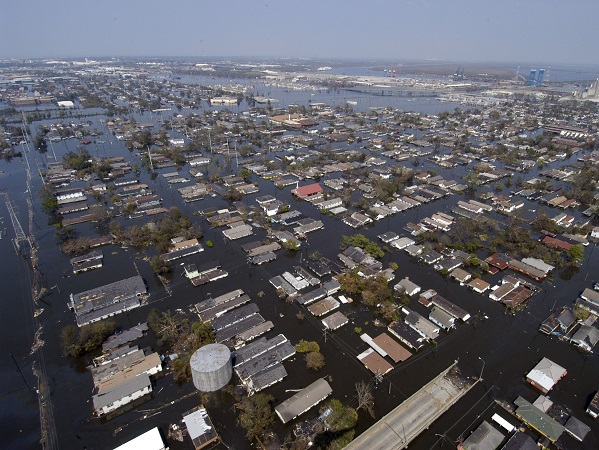
050902-N-5328N-228 New Orleans (Sept. 2, 2005) - Four days after Hurricane Katrina made landfall on the Gulf Coast, many parts of New Orleans remain flooded. The Navy's involvement in the humanitarian assistance operations is led by the Federal Emergency Management Agency (FEMA), in conjunction with the Department of Defense. U.S. Navy photo by Gary Nichols (RELEASED)
The Team
John Pardue, Department of Civil & Environmental Engineering, Louisiana State University, [email protected]
Beth Butler, A Community Voice, [email protected]
Results
The focus of the Lower 9th Ward New Orleans project was to work with a hydrologist to better understand and tackle the chronic flooding and blight issues the neighborhood has faced since Hurricane Katrina hit in 2005. Abandoned and blighted properties left in the wake of the storm exacerbate stormwater flooding, create an unsafe environment for young people, harbor illicit behavior, attract unwelcome wildlife and often trigger PTSD in those that survived the storm. Given the complex social and environmental factors these properties present, Beth Butler and Dr. John Pardue identified a creative way to address the issue: bioswales. These low-maintenance nature parks store and treat stormwater on-site, while providing an aesthetically pleasing environment, filled with native plants that can help improve air quality.
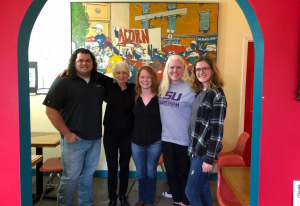
Beth Butler (2nd from left) poses with LSU Engineering students
John’s environmental engineering students at LSU worked with Beth and A Community Voice to develop design criteria for bioswales that can store and treat stormwater prior to discharge into adjacent waterbodies. This included laboratory experiments, community consultation, and mathematical modeling.
A large component of this work was to consult with community members in the Lower 9th Ward on their vision for bioswales. Together, with Beth’s guidance, the LSU students identified people with strong knowledge to speak to the issue of blight and flooding. Community members were interviewed about the history of the ward and asked about the value of bioswales in improving the chronic blight, flooding, and air quality issues. LSU students produced a report detailing the interviews, a cost analysis, as well as their methodology for testing bioretention and air pollution remediation (see below).
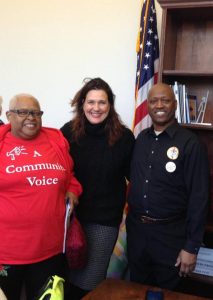
Debra Campell and Rev. Richard Bell of A Community Voice with Councilwoman Kristin Palmer (center)
During the project, the team had two meetings with New Orleans council members. A Community Voice has also reached out to the mayor’s office about adopting a more comprehensive plan for addressing the abandoned and blighted properties across the 9th Ward. The city is currently clearing lots and the group wants to reduce the regulatory hurdles preventing them from installing bioswales on abandoned lots.
What’s Next
A Community Voice plans to continue its efforts in lobbying New Orleans’ government to adopt a plan for addressing blighted properties that includes bioswales. In the meantime, John and LSU will be exploring opportunities to install some bioswale pilots – which ideally can be showcased to others to expand a program.
Project Outputs:
Articles
Community group demands action from city on blight, WDSU News, December 13, 2018
Blight to Bioswales: LSU CEE Student Project to Health Lower Ninth Ward, LSU College of Engineering, January 31, 2019
LSU student project designed to help Lower 9th Ward, NOLA.com, February 1, 2019
Project Impacts:
Reflections
From this project, others may learn better ways to partner with Thriving Earth Exchange for their own purposes. For instance,
The team noted that the following contributed to the success of the project:
However, there were a few key things that the team would do differently if they had the chance to do this project again:
To other teams currently pursuing Thriving Earth Exchange projects and for those that anticipate doing a Thriving Earth Exchange project, the team recommends:
The largest of New Orleans’ 17 wards, the 9th Ward is located on the easternmost downriver portion of the city. In the early 1920s, in order to connect the Mississippi River to Lake Pontchartrain, an industrial canal was dredged through the neighborhoods fringing the river. During Hurricane Katrina in 2005, the neighborhoods on either side of the Industrial canal experienced catastrophic flooding. The Lower 9th Ward garnered national attention with photos and footage of residents stranded on rooftops and helicopters rescuing residents trapped by the flood waters.
In the years following Katrina, residents of the 9th Ward continue to face a variety of challenges related to water-main breaks, sewage back-ups, mold/mildew outbreaks, and the long-term threat of sea level rise. Although the ward has yet to experience flooding as catastrophic as Katrina, smaller flood events have occurred. During an August 5, 2017 storm that dropped close to 10 inches in some neighborhoods, the pumps installed to prevent flooding throughout New Orleans failed, and water ended up pooling in the streets with nowhere to drain. Contaminated drinking water prompted boil advisories for 9th Ward residents and this left many worried about the next big storm.
In addition to these chronic issues, 9th Ward residents have complained about disruptive explosions occurring along the industrial canal. Residents have noted cracked walls as a result of the blasts and remain confused about the nature of the activities.
In 2009, a local non-profit group called A Community Voice was established to provide a community voice to the working, poor, elderly, women, children and families in New Orleans. The organization brings together people with common interests and concerns related to issues that affect their everyday lives. A Community Voice would like to obtain a better understanding of the causes of flooding in the 9th Ward, the reason for the explosions along the canal, and how changes to the canal and levee will affect flooding in their neighborhood. The organization would like to work with a dedicated hydrologist to investigate the flooding, synthesize any available reports and develop next steps or proposed solutions. A Community Voice will use their enhanced understanding to have productive interactions with local decision-makers.
This project has been conceived and designed in partnership with community leaders at A Community Voice and with our national partner, Flood Forum USA.
During AGU’s 2021 Fall Meeting in New Orleans, we were honored to meet many community members who are working to make the region’s neighborhoods healthier, more connected and more resilient. Here’s a glimpse of what we saw.
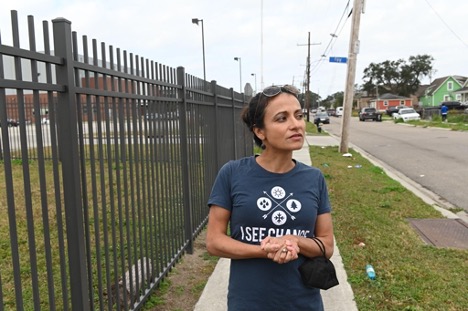 Community lead Julia Kumari Drapkin stands in front of a football field in Gentilly, now the site of a water retention project. The community-sourced data from the Gentilly Thriving Earth Exchange project was a catalyst that resulted in remodeling and reallocation of $4.8 million in flood mitigation to the St. Bernard Campus in Gentilly. The underground unit was expanded by 2.5x, storing up to 5 million gallons of stormwater in underground detention basins – the largest of its kind in the South.
Community lead Julia Kumari Drapkin stands in front of a football field in Gentilly, now the site of a water retention project. The community-sourced data from the Gentilly Thriving Earth Exchange project was a catalyst that resulted in remodeling and reallocation of $4.8 million in flood mitigation to the St. Bernard Campus in Gentilly. The underground unit was expanded by 2.5x, storing up to 5 million gallons of stormwater in underground detention basins – the largest of its kind in the South.
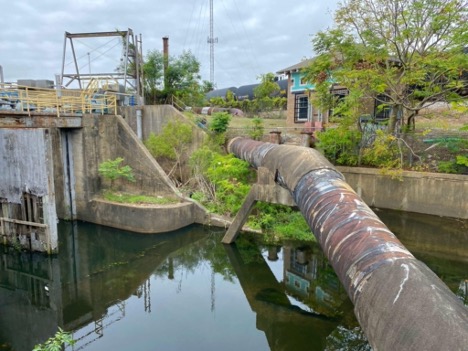 A view of Pumping Station No. 3 in the 7th Ward. Flood control infrastructure is critical in New Orleans 24/7 – there’s someone on the job at every pumping station in the city at all hours, every day, 365 days a year. Here, we see the canal and the transfer pipe that moves water out of the neighborhood and pumps it to Lake Pontchartrain.
A view of Pumping Station No. 3 in the 7th Ward. Flood control infrastructure is critical in New Orleans 24/7 – there’s someone on the job at every pumping station in the city at all hours, every day, 365 days a year. Here, we see the canal and the transfer pipe that moves water out of the neighborhood and pumps it to Lake Pontchartrain.
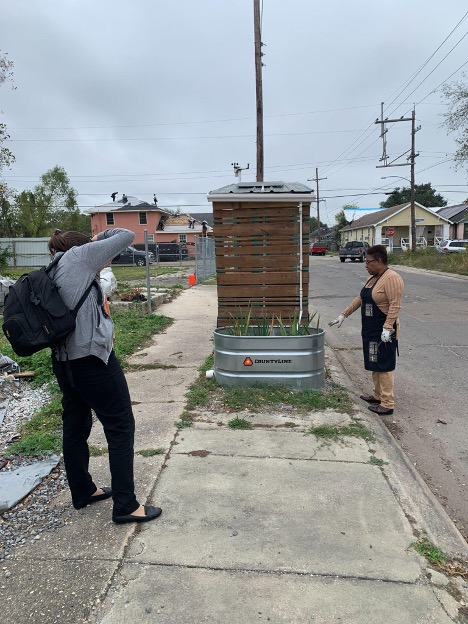 AGU Design director Beth Bagley photographs Angela Chalk, founder of Healthy Community Services, in front of a bus shelter designed with a slanted roof and rain garden to reduce flooding. It also includes a solar-powered charging station that residents can use to power up electronics – a valuable resource if power is lost due to hurricanes or other climate catastrophes. Angela Chalk served as community lead on a Thriving Earth project on monitoring the effects of greening on the urban heat island effect, water uptake, and social challenges and is serving as a Community Science Fellow on a new project in the 7th Ward.
AGU Design director Beth Bagley photographs Angela Chalk, founder of Healthy Community Services, in front of a bus shelter designed with a slanted roof and rain garden to reduce flooding. It also includes a solar-powered charging station that residents can use to power up electronics – a valuable resource if power is lost due to hurricanes or other climate catastrophes. Angela Chalk served as community lead on a Thriving Earth project on monitoring the effects of greening on the urban heat island effect, water uptake, and social challenges and is serving as a Community Science Fellow on a new project in the 7th Ward.
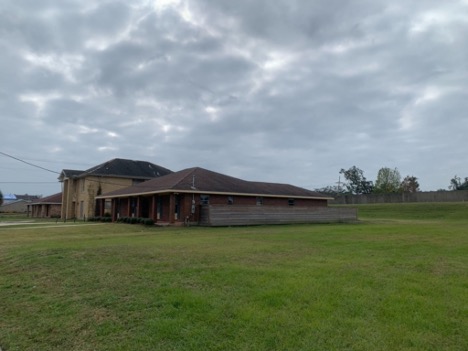 The Flooded House Museum at the breach site of the London Avenue Canal flood wall is a sobering reminder of the impacts of Hurricane Katrina. During the storm, the house was pushed across the street and turned around 180 degrees. Today, it has been returned to its original plot, and is preserved as a museum where visitors can look in through storm windows to see how the hurricane devastated its interior. The London Avenue Canal’s flood wall can be seen in the background; the wall was breached just yards from where the house stood.
The Flooded House Museum at the breach site of the London Avenue Canal flood wall is a sobering reminder of the impacts of Hurricane Katrina. During the storm, the house was pushed across the street and turned around 180 degrees. Today, it has been returned to its original plot, and is preserved as a museum where visitors can look in through storm windows to see how the hurricane devastated its interior. The London Avenue Canal’s flood wall can be seen in the background; the wall was breached just yards from where the house stood.
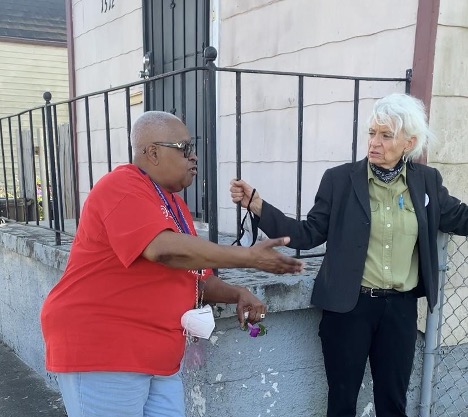 Community lead Beth Butler and resident Debra Campbell stand at the corner at the site of a future bioswale and affordable housing in New Orleans’ 8th Ward. The planned design integrates native plant gardens and private outdoor space to promote residents’ physical and mental health as part of the Thriving Earth projects Designing Bioswales for Improved Air Quality, Serenity and Reduced Flood Risk and Assessing Flooding and Hydrodynamics for Community Revitalization.
Community lead Beth Butler and resident Debra Campbell stand at the corner at the site of a future bioswale and affordable housing in New Orleans’ 8th Ward. The planned design integrates native plant gardens and private outdoor space to promote residents’ physical and mental health as part of the Thriving Earth projects Designing Bioswales for Improved Air Quality, Serenity and Reduced Flood Risk and Assessing Flooding and Hydrodynamics for Community Revitalization.
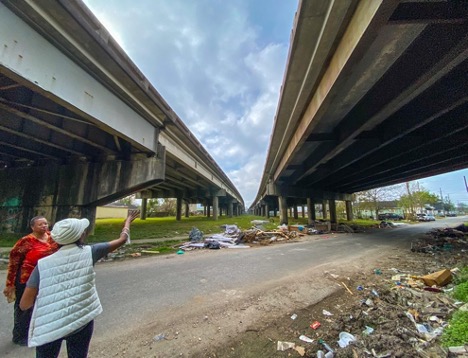 Community leads Amy Stelly and Tamah Yisrael pointing out the I-10 corridor in the 7th Ward, New Orleans. Their organization, Claiborne Avenue Alliance, worked with Thriving Earth Exchange to evaluate the impacts of Highway I-10 that runs above Claiborne Avenue. Their work contributed to a national conversation with New Orleans at its center.
Community leads Amy Stelly and Tamah Yisrael pointing out the I-10 corridor in the 7th Ward, New Orleans. Their organization, Claiborne Avenue Alliance, worked with Thriving Earth Exchange to evaluate the impacts of Highway I-10 that runs above Claiborne Avenue. Their work contributed to a national conversation with New Orleans at its center.
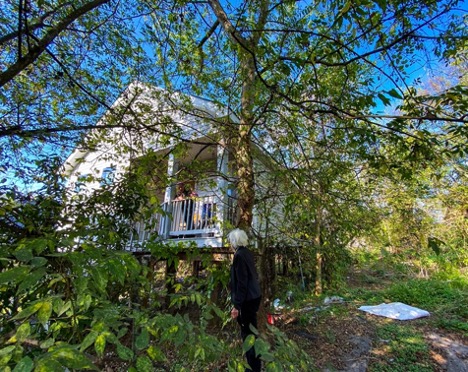 Visiting flood-affected homes in the 9th Ward, New Orleans, with community lead Beth Butler. Raising homes on stilts like this protects them from floods; the lot next door will be developed into a rain garden and bioswale to provide further flood protections and beautify the neighborhood.
Visiting flood-affected homes in the 9th Ward, New Orleans, with community lead Beth Butler. Raising homes on stilts like this protects them from floods; the lot next door will be developed into a rain garden and bioswale to provide further flood protections and beautify the neighborhood.
Community Lead
Bio coming soon!
Beth Butler, Executive Director of A Community Voice, and Reverend Richard Bell, board member of A Community Voice, are community leads on the project.
Scientific Liaison
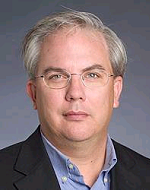
Dr. John Pardue is the Elizabeth Howell Stewart Professor of Civil & Environmental Engineering at Louisiana State University. He directs the Hazardous Substance Research Center at LSU. Dr. Pardue’s research group investigates the fate and transport of chemicals in the environment focused primarily on chemicals in wetlands and aquatic systems, environmental impacts of disasters and shoreline restoration techniques. Currently he is performing research on the fate and remediation options for the Deepwater Horizon oil spill in Louisiana marshes and barrier islands. He has published over 70 peer-reviewed papers and conducted research for federal agencies such as EPA, NSF, NOAA, and DOD. His research has led to development of a number of innovative technologies including the sustainable constructed wetland approach for treating contaminated groundwater. His group published the first peer-reviewed scientific paper on Hurricane Katrina (Pardue, J.H., W.M. Moe, D. McInnis, L.J. Thibodeaux, K.T. Valsaraj, E. Maciasz, I. van Heerden, N. Korevec and Q.Z. Yuan. 2005. Chemical and microbiological parameters in New Orleans floodwater following Hurricane Katrina. Environ. Sci. Technol. 39:8591 – 8599).
This project is part of one of Thriving Earth Exchange’s new cohorts. Thriving Earth Exchange has partnered with Flood Forum USA which supports grassroots flood groups across the country by helping them develop strategies for a sustainable future. Thriving Earth Exchange is working with 15 of their grassroots groups to connect them with scientists who can help them better characterize neighborhood-level flood risks and work effectively with local decision makers to mitigate those risks.
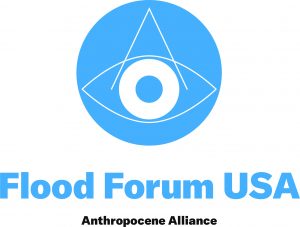
ISeeChange is dedicated to empowering communities to document and understand their environment, weather and climate in order to increase resilience. ISeeChange mobilizes communities to share stories and micro-data about climate impacts to inform and improve climate adaptation and infrastructure design. Their platform, tools, and investigations provide equitable, iterative ways for residents to personalize, measure, and track climate change impacts and better participate in community adaptation decisions.
Each post is synced with weather and climate data and broadcast to the community to investigate bigger picture climate trends. Over time, community members can track how climate is changing, season to season, year to year, and understand the impacts on daily life.
ISeeChange is a strategic partner of Thriving Earth Exchange as community members use their platform and tools to better characterize, visualize, and communicate neighborhood-level climate trends and co-develop solutions to mitigate those risks.
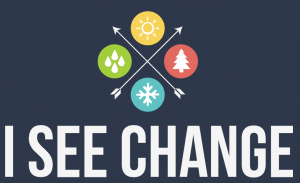
(c) 2024 Thriving Earth Exchange